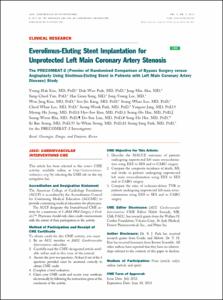KUMEL Repository
1. Journal Papers (연구논문)
1. School of Medicine (의과대학)
Dept. of Internal Medicine (내과학)
Everolimus-Eluting Stent Implantation for Unprotected Left Main Coronary Artery Stenosis
- Keimyung Author(s)
- Hur, Seung Ho
- Department
- Dept. of Internal Medicine (내과학)
- Journal Title
- JACC: Cardiovascular Interventions
- Issued Date
- 2012
- Volume
- 5
- Issue
- 7
- Abstract
- Objectives:
This study sought to evaluate the safety and efficacy of second-generation drug-eluting stents (DES) for patients with unprotected left main coronary artery (ULMCA) stenosis.
Background:
The clinical benefit of second-generation DES for ULMCA stenosis has not been determined.
Methods:
The authors assessed 334 consecutive patients who received everolimus-eluting stents (EES) for ULMCA stenosis between 2009 and 2010. The 18-month incidence rates of major adverse cardiac or cerebrovascular events (MACCE), including death, myocardial infarction (MI), stroke, or ischemia-driven target vessel revascularization (TVR), were compared with those of a randomized study comparing patients who received sirolimus-eluting stents (SES) (n = 327) or coronary artery bypass grafts (CABG) (n = 272).
Results:
EES (8.9%) showed a comparable incidence of MACCE as SES (10.8%; adjusted hazard ratio [aHR] of EES: 0.84; 95% confidence interval [CI]: 0.51 to 1.40; p = 0.51) and CABG (6.7%, aHR of EES: 1.40; 95% CI: 0.78 to 2.54; p = 0.26). The composite incidence of death, MI, or stroke also did not differ among patients receiving EES (3.3%), SES (3.7%; aHR of EES: 0.63; 95% CI: 0.27 to 1.47; p = 0.29), and CABG (4.8%; aHR of EES: 0.67; 95% CI: 0.29 to 1.54; p = 0.34). However, the incidence of ischemia-driven TVR in the EES group (6.5%) was higher than in the CABG group (2.6%, aHR of EES: 2.77; 95% CI: 1.17 to 6.58; p = 0.02), but comparable to SES (8.2%, aHR of EES: 1.14; 95% CI: 0.64 to 2.06; p = 0.65). Angiographic restenosis rates were similar in the SES and EES groups (13.8% vs. 9.2%, p = 0.16).
Conclusions:
Second-generation EES had a similar 18-month risk of MACCE for ULMCA stenosis as first-generation SES or CABG.
- Keimyung Author(s)(Kor)
- 허승호
- Publisher
- School of Medicine
- Citation
- Young-Hak Kim et al. (2012). Everolimus-Eluting Stent Implantation for Unprotected Left Main Coronary Artery Stenosis. JACC: Cardiovascular Interventions, 5(7), 708–717. doi: 10.1016/j.jcin.2012.05.002
- Type
- Article
- ISSN
- 1936-8798
- Appears in Collections:
- 1. School of Medicine (의과대학) > Dept. of Internal Medicine (내과학)
- 파일 목록
-
-
Download
 oak-aaa-2640.pdf
기타 데이터 / 646.33 kB / Adobe PDF
oak-aaa-2640.pdf
기타 데이터 / 646.33 kB / Adobe PDF
-
Items in Repository are protected by copyright, with all rights reserved, unless otherwise indicated.